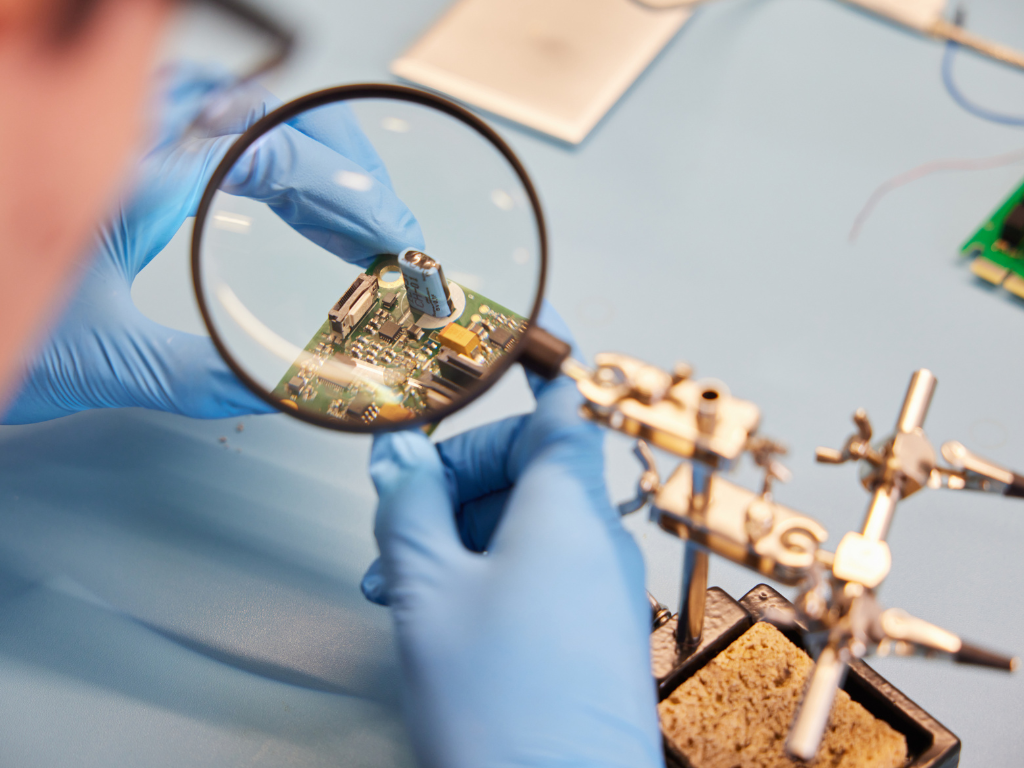Our Research
Innovating at the system level to enable novel space services
Services and infrastructures in space are vital for our society, and rely on increasingly sophisticated systems. The Space Systems Engineering (SpaSys) group conducts research and development on novel space services based on space systems that are miniaturised and distributed, including ChipSats and CubeSats, and operated in swarms and formations. They also conduct research on in-space manufacturing and in-situ resource utilisation.
Launching a
Pioneering and
Distributed
Satellite Network

Research projects
Our Projects
-
Duration:*
09/2020-09/2022
-
Funding source:*
SNT
-
Researchers:*
Prof. Miguel Olivares-Mendez, Prof. Holger Voos, Prof. Andreas Hein, Prof. Djamila Aouada, Dr. Carol Martinez-Luna, Dr. Baris Yalcin, Dr Jan Thoemel, Dr Loveneesh Rana, Dr Olivia Borgue, Dr. Mohammadamin ALANDIHALLAJ, Zhanna Bokal
-
Partners:*
SpaceR (SnT), SPASYS (SnT), CVI2 (SnT), and ARG (SnT)
-
Description:*
Zero-G project focusses on developing and applying a state-of-the-art research facility that emulates near-gravity-free environment to develop and test multiple in-space capabilities. The project is organized through a collaboration of SnT research groups as follows: SpaceR, CVI2, ARG, and SPASYS.
The overall objectives of project are as follows:- Develop specific platforms with the ability to perform different experiments with reduced payloads during short-term experiments with multiple platforms using air-bottles
- Develop a platform for long-term experiments by using a constant air-supply to the platform using a pipe guided by a robotic arm on the ceiling (and maybe a second arm guided by the wall or ceiling mounted robotic).
- Develop the control and trajectory planning of the robotic arms on the walls and ceiling rails
- Develop a robust control approach to operate the platforms to emulate a large number of scenarios and satellite behavior with high precision and repeatability, such as satellite drifting, tumbling and other non-collaborative behaviors.
- Develop a Sun simulation system with a robotic high-power floodlight to recreate the Sun in position, orientation and movement for a specific satellite orbit and speed and orbit for vision-based experiments.
-
Project details (PDF):*
-
Duration:*
09/2020-09/2022
-
Funding source:*
SNT
-
Researchers:*
Prof Symeon Chatzinotas, Prof Andreas Hein, Prof Miguel Olivares, Dr Jorge Querol, Dr Juan Carlos Merlano Duncan, Dr Nicola Maturo, Dr Sumit Kumar, Dr Oltjon Kodheli, Jevgenij Krivochiza, Dr Jan Thoemel, Dr Loveneesh Rana, Dr Olivia Borgue, Dr Carol Martinez Luna, Zhanna Bokal
-
Partners:*
SIGCOM (SnT), SPASYS (SnT), and SpaceR (SnT)
-
Description:*
The 5G Space Communications Lab (5G-SpaceLab) is a joint project of the CDF, CubeSatLab, LunaLab and SatComLab of SnT to create a unique integrated and interdisciplinary space communications and control emulation platform for the next-generation of space applications. The 5G-SpaceLab will allow to test, validate and demonstrate space operations for two different scenarios: Earth-orbiting satellite communications and Earth-Moon communications. The main goal of 5G-SpaceLab during the first year is to build a demonstration testbed and to present its initial capacities to the relevant industrial and government actors. The mentioned capacities include the evaluation of different small satellite formation control and cooperation configurations for non-terrestrial 5G networks or the realistic emulation of a space mission control room for communications and remote control of lunar rovers.
-
Project details (PDF):*
-
Duration:*
Jan 2022 – Feb 2023
-
Funding source:*
SPASYS (SnT)
-
Researchers:*
Prof. Andreas Hein, Dr Olivia Borgue, Dr Jan Thoemel, Dr Loveneesh Rana, Konstantinos Kanavouras
-
Partners:*
N/a
-
Description:*
ChipSats are spacecraft that have all their components integrated on a single PCB board, weighing less than 100 grams. As a technology demonstration mission, SpaSys is designing a 5 × 5 cm ChipSat that will be mounted on a larger spacecraft in Low Earth Orbit, but will be completely independent in terms of power, communications and processing. The system will illustrate how Visible Light Communication can be used for low-cost links between small satellites, only using off-the-shelf LEDs and light sensors. This architecture can be used for future distributed satellites, where different spacecraft perform different functions around a celestial body.
-
Project details (PDF):*
-
Duration:*
01/2022 – 10/2022
-
Funding source:*
SNT
-
Researchers:*
Prof. Andreas Hein, Prof. Djamila Aouada, Dr Jan Thoemel, Dr Loveneesh Rana, Dr Olivia Borgue, Dr Arunkumar Rathinam, Konstantinos Kanavouras, Maanasa Sachidanand
-
Partners:*
SPASYS (SnT) and CVI2 (SnT)
-
Description:*
The objective of AI4Space project is to test state-of-the-art Deep Learning approaches to fully utilize the potential of edge Artificial Intelligence (AI) in space for quick reaction in case of a radiation event or any other fault in the spacecraft based on its thermal signature. Towards this end, SPASYS and CVI2 research groups from SNT are developing a chipsat mission that is scheduled to be launched in Q4 2022.
The chipsat spacecraft will host a compact infrared payload that will monitor the satellite’s electronics to spot any behavior outside the nominal operating conditions and to trigger an alarm. This event can be identified on-board by applying a machine learning-based anomaly detection algorithm, which will allow the operators to execute the appropriate counter measurements to ensure smooth system operability and increase the mission lifetime of the satellite. -
Project details (PDF):*
-
Duration:*
09/2021 – 09/2022
-
Funding source:*
ESA – European Space Agency
-
Researchers:*
Prof. Symeon Chatzinotas (SnT- SIGCOM)
Dr. Houcine Chougrani (SnT- SIGCOM)
Dr. Oltjon Khodehli (SnT- SIGCOM)
Dr. Jan Thoemel (SnT- SPASYS)
Prof. Mahulena Hofmann (SnT- SES Chair) -
Partners:*
SIGCOM (SnT) and SPASYS (SnT)
-
Description:*
The main objective of SAT-SPIN project is to perform a feasibility study on using space-based internet systems for space missions. In particular, the study should firstly focus on identifying and analysing relevant characteristics of the current and near future space-based internet providers including the terminal technology used, the orbital parameters, the frequency bands, the communication protocols, the targeted customers, etc. Moreover, considering the fact that 5G services via satellite are one of the most promising use cases of the future, the analysis shall also include the possibility to access a specific LEO satellite (space mission) from a 5G network connection. Second, the project shall identify the most important space missions that can take advantage of internet (or 5G) based space services, analyse possible limitations and compare various features of a potential solution with the already existing operational communication scenarios. The spacecraft aspects shall also be covered, combining a preliminary design of the satellite’s flight segment and communication payload in the context of satellite to space-based internet provider network. Third, the relevant communication protocols to connect space mission satellites via space-based internet provider should be analyzed. Last but not least, the activity shall also focus on potential legal aspects of the RF spectrum usage and cover the next steps for the development and exploitation of any identified potential solution.
-
Project details (PDF):*
-
Duration:*
02/2022 – 07/2023
-
Funding source:*
ESA – European Space Agency
-
Researchers:*
Prof. Symeon Chatzinotas (SnT- SIGCOM)
Dr. Houcine Chougrani (SnT- SIGCOM)
Dr. Oltjon Khodehli (SnT- SIGCOM)
Dr. Jorge QUEROL (SnT- SIGCOM)
Dr. Sumit Kumar (SnT- SIGCOM)
Abdelrahman Abdella (SnT- SIGCOM)
Dr. Jan Thoemel (SnT- SPASYS) -
Partners:*
SIGCOM (SnT) and SPASYS (SnT)
-
Description:*
The project will focus on the adaptation of the existing terrestrial systems to the expected communications scenarios in Lunar missions. It is expected to investigate existing terrestrial technologies and evaluate their suitability for the implementation in the form of a network card unit to be integrated into a series of target devices. In a nutshell, the objectives of the activity are:
- To investigate the existing terrestrial technologies and evaluate their suitability for Moon exploration scenarios;
- o identify the means to implement the technologies as well as all the modifications required to existing hardware and software/firmware;
- o design a network card unit to be integrated into a series of target devices: perform the architectural design of the flight unit and the design and implementation of the relevant breadboard prototypes;
- To demonstrate compliance to the requirements via review of design, analysis and test on the breadboard prototypes.
In particular, the project should first focus on the requirements definition depending on the selected scenarios, communications architectures as well as conditions and characteristics of the lunar environments. Through this important system parameters, requirements and KPIs are defined like the required data rate, degree of reliability, required Size, Weight and Power (SWAP), channel conditions and many others. The objective of this step is to facilitate the selection of the best-fit terrestrial technology for lunar proximity communications scenarios. Second, the activity will identify the candidate standards and technologies for Lunar communication, perform trade-offs and necessary adaptation if exist and propose a detailed architecture of the flight network card unit and the breadboards. The blocks and interfaces forming the aforementioned architecture should also be identified and defined. Moreover, the space-qualification aspects of breadboards should be assessed. Last but not least, the breadboards should be implemented, tested, and validated via pre-defined Verification and Validation Plan.
-
Project details (PDF):*
[please send all files to livia.formisani@ext.uni.lu]
-
Duration:*
05/2022 – 05/2023
-
Funding source:*
This project is funded by the European Space Agency (ESA) ARTES Future Preparation
-
Researchers:*
Dr Eva Lagunas (SnT)
Dr Flor G. Ortiz (SnT)
Dr. Wallace Martins (SnT)
Dr. Jan Thoemel (SnT)
Prof. Symeon Chatzinotas (SnT)
Prof. Osvaldo Simeone (KCL)
Dr. Bipin Rajendran (KCL) -
Partners:*
SIGCOM (SnT) and SPASYS (SnT)
-
Description:*
The project NeuroSat aims to identify the potential benefits of using neuromorphic processors (NPs) implementing spiking neural networks (SNN) for SatCom applications. The study’s primary outcomes will be to inform the community of the capabilities and feasibility of implementing neuromorphic processors in SatCom systems and to define the technological developments needed to make them a reality.
The proposed activity will take the form of an investigation into the implementation of NP architectures in SatCom systems, focusing on AI-based applications that require massive parallelism, processing of streaming data, energy efficiency, and adaptation. We will identify such applications, describe NP systems tailored for SatCom, present a prototypical implementation using Intel’s Loihi NP, and trace a path ahead for research and implementation of neuromorphic computing for SatCom.
The project will be carried out by University of Luxembourg (UL), which will contribute its expertise on SatCom, and King’s College London (KCL), whose team members have a longstanding experience in the design and implementation of NPs and SNNs. -
Project details (PDF):*
-
Duration:*
10/2020 – 04/2024
-
Funding source:*
EU Horizon 2020
-
Researchers:*
Dr. Jan Thoemel, Johannes Laur
-
Partners:*
KU LEUVEN, NEUTRON STAR SYSTEMS, UNIVERSITE DU LUXEMBOURG (SnT), UNIVERSITY OF SOUTHAMPTON, ABSOLUT SYSTEM, VON KARMAN INSTITUTE FOR FLUID DYNAMICS, KARLSRUHE INSTITUTE OF TECHNOLOGY, UNIVERSITY OF STUTTGART, INSTITUTE OF SPACE SYSTEMS, THEVA, AEDS
-
Description:*
Re-entry represents one of the most critical phases of space missions, subjecting spacecraft to high temperatures and disrupting their communications. The Horizon 2020 – FET-OPEN Project: MEESST aims at filling the gap between research and application, towards the development of a first-of-its-kind demonstrator implementing active magnetic shielding. This new technology can supply the magnetic fields needed to mitigate heat flux and radio communications blackout during spacecraft re-entry.
The mission of this project is to design, build, and test a first proof-of-concept magnetic shielding device for mitigating both thermal loads and radio blackout during space entry.
MEESST aims to- enable reusability and accurate positioning for in-space transportation vehicles.
- enable an increase in the amount of scientific data that can be transmitted by scientific probes during atmospheric entry.
- enable a lighter, more compact, more cost-effective, and safer protection system for sample return missions, asteroid mining, and in-space cargo transfers.
- harmonize existing numerical simulation codes for re-entry physics, and verify their predictions against experimental data.
- take a step forward towards a fully-capable numerical code for simulating atmospheric re-entry and MHD interactions.
- shift the focus of re-entry shielding away from material design, to magnetic shielding.
-
Project details (PDF):*
